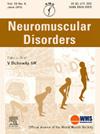“Natural history of skeletal muscle laminopathies: a 2-year prospective study”
IF 2.7
4区 医学
Q2 CLINICAL NEUROLOGY
引用次数: 0
Abstract
Skeletal muscle laminopathies (SMLs) are rare disorders characterized by skeletal muscle involvement caused by mutations in LMNA gene. To date, the natural history of SMLs has not been clearly elucidated. Through a 2-year prospective study, we aimed to describe the natural history of SMLs. We enrolled 26 SMLs patients, assessed with: North Star Ambulatory Assessment scale (NSAA), timed tests, manual muscle testing, joint range of motion, six-minutes walking test (6MWT); respiratory evaluation including forced vital capacity (FVC) and forced expiratory volume at 1 second (FEV1); individualized neuromuscular quality of life (INQoL). Muscular performance with the aforementioned tools significantly correlated with phenotypes at the baseline, showing the worse outcome in those with autosomal dominant Emery-Dreifuss muscular dystrophy as compared to limb girdle phenotype. NSAA score significantly (p = 0.0005) worsened during the 2-year follow-up. Moreover, the respiratory function through FVC and FEV1 significantly (p = 0.0086 and p = 0.0290, respectively) deteriorated over the follow-up period. 6MWT, INQoL and timed tests did not significantly change, as well as ankle, knee, and elbow contractures. This study showed a slow progression of motor and respiratory function in SMLs patients over a period of 2 years.
骨骼肌椎板病的自然史:一项为期两年的前瞻性研究。
骨骼肌层压病(SMLs)是一种罕见的疾病,其特征是由LMNA基因突变引起的骨骼肌受累。迄今为止,sml的自然历史还没有被清楚地阐明。通过一项为期2年的前瞻性研究,我们旨在描述sml的自然历史。我们招募了26例SMLs患者,采用North Star动态评估量表(NSAA)、定时测试、手动肌肉测试、关节活动范围、6分钟步行测试(6MWT)进行评估;呼吸评估包括用力肺活量(FVC)和1秒用力呼气量(FEV1);个性化神经肌肉生活质量(INQoL)。使用上述工具的肌肉表现与基线表型显着相关,显示常染色体显性埃默里-德莱弗斯肌营养不良症患者的预后比肢体带状表型更差。NSAA评分在2年随访期间显著恶化(p = 0.0005)。此外,FVC和FEV1在随访期间的呼吸功能显著恶化(p = 0.0086和p = 0.0290)。6MWT、INQoL和定时测试没有明显变化,脚踝、膝盖和肘部收缩也没有明显变化。这项研究表明,在2年的时间里,SMLs患者的运动和呼吸功能进展缓慢。
本文章由计算机程序翻译,如有差异,请以英文原文为准。
求助全文
约1分钟内获得全文
求助全文
来源期刊

Neuromuscular Disorders
医学-临床神经学
CiteScore
4.60
自引率
3.60%
发文量
543
审稿时长
53 days
期刊介绍:
This international, multidisciplinary journal covers all aspects of neuromuscular disorders in childhood and adult life (including the muscular dystrophies, spinal muscular atrophies, hereditary neuropathies, congenital myopathies, myasthenias, myotonic syndromes, metabolic myopathies and inflammatory myopathies).
The Editors welcome original articles from all areas of the field:
• Clinical aspects, such as new clinical entities, case studies of interest, treatment, management and rehabilitation (including biomechanics, orthotic design and surgery).
• Basic scientific studies of relevance to the clinical syndromes, including advances in the fields of molecular biology and genetics.
• Studies of animal models relevant to the human diseases.
The journal is aimed at a wide range of clinicians, pathologists, associated paramedical professionals and clinical and basic scientists with an interest in the study of neuromuscular disorders.
 求助内容:
求助内容: 应助结果提醒方式:
应助结果提醒方式:


